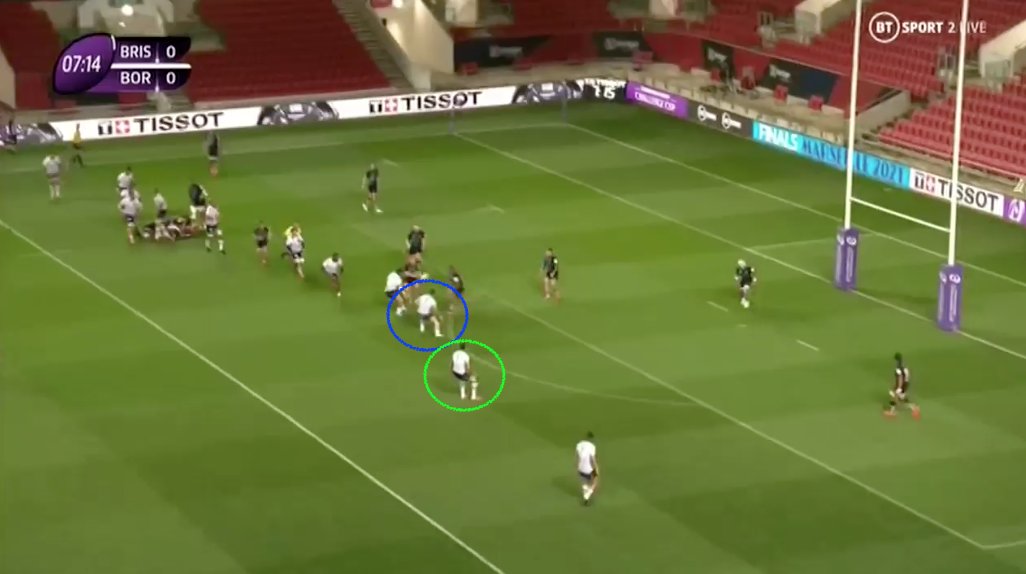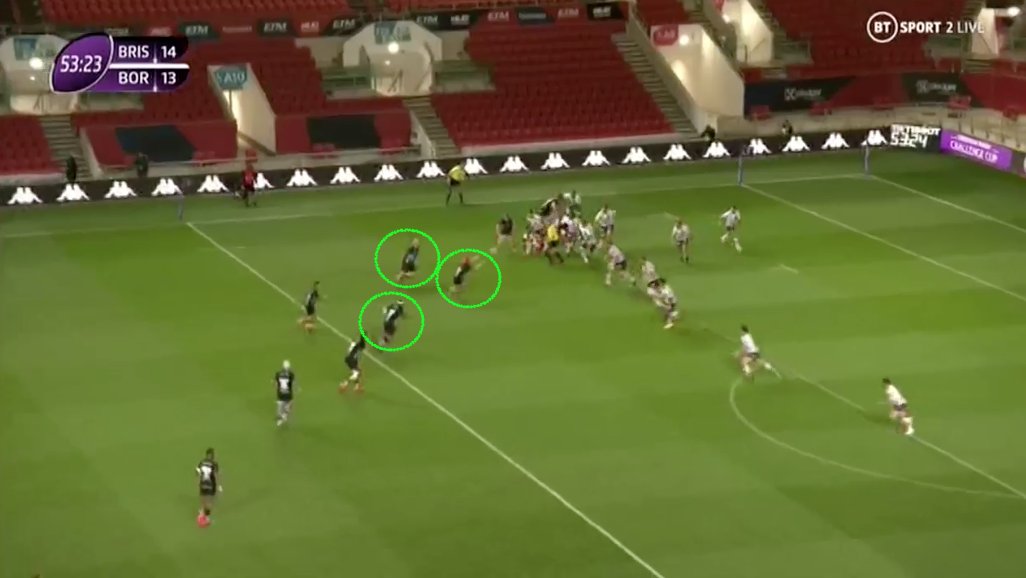Thread: Watch Like an Analyst - Copying and Pasting the Bristol Attack
How your club can attack like the Bears
Focus: Attacking shape and attacking lines
1/
How your club can attack like the Bears
Focus: Attacking shape and attacking lines
1/
I make no apology for writing a lot about the Bears recently. They are absolutely fascinating and a lot can be learnt from them.
In addition, I want to do more analysis on women& #39;s rugby but I only have the women& #39;s Six Nations to go after in terms of footage.
2/
In addition, I want to do more analysis on women& #39;s rugby but I only have the women& #39;s Six Nations to go after in terms of footage.
2/
To understand how Bristol& #39;s attack works, let& #39;s do the basics. I& #39;ve explained this before but a lot of Bristol& #39;s success is down to well executed hard and soft lines.
A hard line is one that goes towards the opposition try line and a soft line is one that goes to the sideline
3/
A hard line is one that goes towards the opposition try line and a soft line is one that goes to the sideline
3/
Look what happens when Harry Thacker receives the ball at first receiver in last night& #39;s game. He has two options: Sinckler running the hard option or Sheedy running the soft option out the back.
4/
4/
Now watch the second pass. Sheedy has a hard option, Luatau, and a soft option, Piutau out the back. Piutau is then able to feed the ball wide and Bristol easily advance out of their own 22.
5/
5/
A fundamental truth of defending is that it is easier to defend if you know what the attacker will do. With two attacking lines (someone running a hard line and someone a soft) each defender finds themself in a situation where they have to cover a number of eventualities.
6/
6/
Imagine you are the guy circled blue. His job is to tackle Sinckler, but if Sinckler is a decoy, his job is to tackle Sheedy. Or in Green. His job is to tackle Piutau, but he also needs to make sure his inside man tackles Sheedy. PLUS, he needs to account for Luatua.
7/
7/
There are a few keys to making this kind of attack work.
- You need your players to delay there passes as long as possible. If Thacker throws his pass as soon as he gets the ball then both blue and green have one less person to worry about, Sinckler cannot be a threat.
8/
- You need your players to delay there passes as long as possible. If Thacker throws his pass as soon as he gets the ball then both blue and green have one less person to worry about, Sinckler cannot be a threat.
8/
This isn& #39;t a bad play, it still gains ground. But look how Sinckler passes a bit earlier than is ideal and the player running the hard line ceases to be a threat. The Bordeaux defenders can push out and leave him unattended.
9/
9/
Compare that with this pass from Sinckler where he waits virtually until contact before passing, as does Sheedy. If you are a defender you are just guessing here whether Earl, then Luatua, gets the pass or not. That creates the space.
10/
10/
Another problem with these lines is it can be all too easy for a succession of players running soft lines to just drift aimlessly across the pitch. Once space opens up you need somebody to run into it. Something Piutau does brilliantly in the above example.
11/
11/
Piutau does the same thing here. It is tempting to just keep going sideways and remove your team mate& #39;s space but Piutau straightens up and creates the space that Nathan Hughes then exploits to barge through the gain line.
12/
12/
Now Bristol are an elite team but there& #39;s no reason why you can& #39;t employ something similar in your attack. A lot of club sides now play with a pod system - that is three forwards stood waiting to receive the ball from the 9.
Like these three below.
13/
Like these three below.
13/
It is a good idea to pass to the middle man, Thacker in this case, because he then has four options:
- Pop Inside
- Pop Outside
- Carry
- Pass out the back
Any team at any level can set up a pod system relatively easily.
14/
- Pop Inside
- Pop Outside
- Carry
- Pass out the back
Any team at any level can set up a pod system relatively easily.
14/
Now you can super charge that by sticking your fly-half, or other playmaker, out the back of the pod (stood just behind the outside member of the pod). Now you have added an out the back option that your fly-half can call.
15/
15/
Again, not very complicated but will require a bit of upskilling to make sure all your forwards can throw that pass. If you have time to set-up a pod then you would be silly not to have your best ball playing forward in the middle.
16/
16/
Already you& #39;ll be looking like a proper team. But go one step further by having your outside pod member run a hard line - THEY MUST EXPECT THE PASS - and your fly-half and can just slide away from them and he becomes your soft option.
17/
17/
What you have done now is made the defender on the outside of the pod make a decision. Does he go with the the hard running pod member or gamble that he won& #39;t receive the pass? If he does go with him then what does the next defender do?
18/
18/
If the next defender steps towards the pod then the fly-half should be able to put the inside centre/another attacker on his outside shoulder through the hole. If the next defender doesn& #39;t move towards the pod then either the fly-half or a blindside winger will go through.
19/
19/
Set-up three defenders to cover the pod, one for the fly-half, and one for the outside attacker and keep running this set-up. It& #39;s fun and tests defenders and attackers. If numbers are good expand by adding a second pod or a lone forward outside your ten to run a hard line.
20/
20/
If it is good enough for the Bears it will be good enough for any other teams as well. In addition to that, take ideas from the pro game. The level and skills are obviously higher, but it& #39;s the same sport and there will be things you can use!
21.
21.

 Read on Twitter
Read on Twitter



